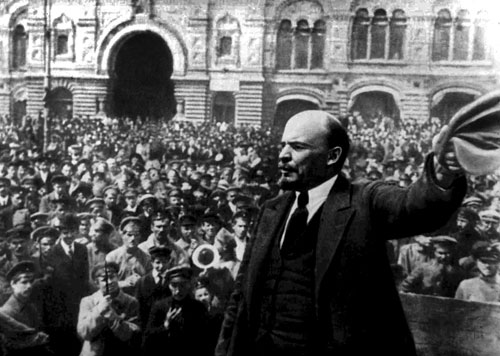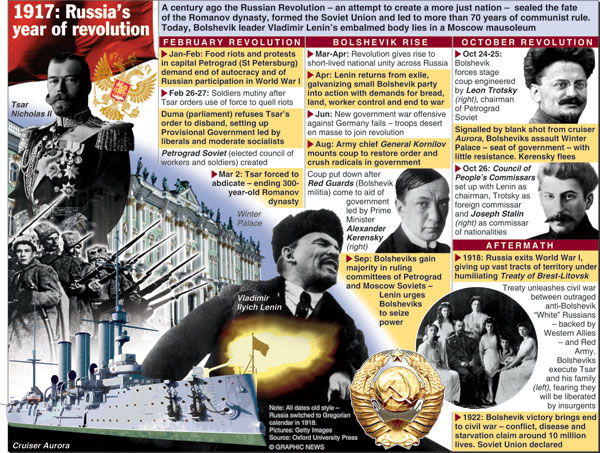Sunday Times 2
100 years on, milestones of Bolshevik Revolution
View(s):The 7th of November this year marks the centenary of the Russian Revolution – an indelible landmark and a turning point in the history of Russia – that established the Communist rule under what became the Soviet Union that is officially known as the Union of Soviet Socialist Republics (USSR).The revolution shaped world politics of the 20th century, and saved the Soviet Union from the brutal war, and propelled it to superpower status. More on that later.
It is called the October Revolution as it happened on October 25 (on the old, Julian calendar), and also known as the Bolshevik (meaning majority) Revolution because it was led by Bolshevik Party leader, Vladimir Ilyich Lenin (1870-1924) – a revolutionary, politician and political theorist.The strategy for the revolution was crafted by the Russians – due to intolerable conditions resulting from centuries of serfdom under which the Russian people suffered during the Czarist autocratic rule.

Vladimir Lenin: The man who led the revolution
Rise of revolutionary movements
To understand the revolution, we need to glance at Russia’s history that dates back to the 8th century Treaty with the Byzantine Empire.
The Emperors of Russia, Peter the Great (1682-1721) made Petrograd (now St. Petersburg) a westernised city, and industrialised Russia. Catherine the Great (1762-1796) further modernised Russia.
By 1900, the Russian Empire comprised nearly one-sixth of the earth’s landmass – rivalled only by the British Empire.
The grandiose buildings such as the Tsar’s Winter Palace (Hermitage) in St. Petersburg, and the Kremlin Palace in Moscow symbolise the opulence, cultural richness, military glory, and pageantry of the Russian monarchy.
The monarchy continued to practise serfdom – a form of feudalism in which landless peasants were forced to serve the land-owning nobility. Thus, Russia was one of the most backward and impoverished countries in Europe. It was also a time of great social, political and cultural movement in Russia as many prominent writers (Pushkin, Tolstoy and Dostoevsky) and musicians (Tchaikovsky) brought Russia into a Golden Age of literature and music. Many intellectuals embraced revolutionary ideals and supported the uprisings that were rapidly growing all over the country.
The upper class (aristocrats, merchants, landlords, industrialists, and the intelligentsia) supported the monarchy while the majority of the population (serfs, factory workers and peasants) belonged to the lower class and lived in absolute poverty and despair. The oppressive system of serfdom in Russia was abolished only in 1861 emancipating more than 20 million serfs. They joined forces with the peasants and industrial workers to organise events leading up to the Russian Revolution.
Momentous rebellions
The first rebellion took place in January 1905 when thousands of people marched to the Winter Palace in Petrograd demanding economic and political reforms. Czar’s troops opened fire and killed several hundred and injured many. The incident came to be known as the “Bloody Sunday Massacre”. That event set off months of violent protests throughout Russia. In October 1905, Czar Nicholas II acceded to limited democratic reforms including a parliament (Duma) but the new government failed as the country was in complete chaos.
The second rebellion began in February 1917, when nearly 90,000 workers – mostly women – staged daily uprisings in Petrograd demanding bread. They were joined by Czar’s military in demanding socialist reforms. That uprising caused Czar Nicholas II to abdicate the throne on March 15, 1917, and install a Provisional Government that sparked liberal reforms but Russia slipped further into anarchy.
By now, Russia was in a social, economic and political crisis as millions of workers in all industries (mining, metals, oil, textiles, railroads, etc.) took part in strikes joined by thousands of peasant uprisings against landowners.Lenin, who promised the masses “peace, land and bread”, returned to Petrograd from self-imposed exile in Switzerland to realise that the Bolsheviks had the support of the workers and soldiers to overthrow the provisional government.
The October Revolution
The final move to capture power began in Petrograd on October 26 (now November 7), when the Bolsheviks took control of the telegraph stations, power stations, strategic bridges, post offices, train stations, and banks, without gunfire or any resistance. The troops loyal to the revolutionaries infiltrated the Winter Palace and without any resistance the Bolsheviks became the new leaders of Russia.
In January 1918, the Bolsheviks proclaimed the Soviets (workers’ elected councils) as the new government of Russia, and Lenin issued over a hundred Decrees on crucial issues such as liquidation of illiteracy, abolish all private land ownership, establish a system of collective and state farms, workers’ control over the factories, and officially ended Russia’s involvement in World War I.
After he abdicated the throne, Czar Nicholas II and his family were held in the Yekaterinburg Palace but they were executed on July 17, 1918 as the Bolsheviks feared that the counterrevolutionary forces would rescue them.
Bloody civil war and the creation of the Soviet Union
Lenin’s government, which established a “dictatorship of the proletariat”, was forced to fight a civil war (1918-22) against anti-Bolshevik forces that caused an estimated 7,000,000 to 12,000,000 casualties mostly civilians, and prompted millions of Russia’s upper class to migrate to other countries.
After their defeat, the world’s first socialist state – USSR – was established in 1922, providing unprecedented social advancement for the peasants and workers, and promoting the equality of men and women.
After Lenin’s death in 1924, Joseph Stalin came to power and initiated a centrally planned economy which led to a period of rapid industrialisation and collectivisation but with another dark chapter known as Stalin’s Purge (1934–38). Stalin removed thousands of his opponents within and outside of the party via arbitrary arrests and persecutions, executed thousands of people as traitors, and imprisoned millions in forced-labour camps.
The Second World War
Another catastrophe the country had to endure was its ferocious war (1941-1945) against Nazi Germany during which the Soviets lost 27 million people, and the whole country was literally destroyed. Since my description of this war may not do justice, I wish to quote from the post-war Nuremberg Trials to describe the damage sustained by the Soviet Union.
According to the testimony presented by General Roman Rudenko at the Military Tribunal in Nuremberg, the largest number of civilian deaths in a single city was 1.2 million Russians dead during the Siege of Leningrad.
The combined damage consisted of complete or partial destruction of 1,710 cities and towns, 70,000 villages, 98,000 collective farms, 2,508 churches, 31,850 factories, 40,000 miles of railroad, 4,100 railroad stations, 6,000 hospitals, 84,000 schools, 43,000 public libraries, and left 25 million homeless – as a direct result of the war.
Appalled by the extent of the carnage during a visit to Russia, Dwight Eisenhower, Commander in Europe during the war, wrote “When we flew into Russia, in 1945, I did not see a house standing between the western borders of the country and the area around Moscow”.
It was thanks to Stalin’s strong leadership, and the bravery of the Soviet people that defeated Nazi Germany, liberated Eastern European countries occupied by Hitler, and captured Berlin in May 1945.Victory in that war, and rebuilding the Soviet Union gave the revolution a historical legitimacy.
The Revolution created a superpower
Despite inconceivable impediments, the Soviet’s managed to rebuild the country propelling it to superpower status.
In 1962, when I arrived in Moscow for a five-year course of graduate studies in International Law, (i.e. just four decades after the Russian revolution and formation of the Soviet Union), I was amazed at the phenomenal accomplishments of the Soviets.
They have been making their own rockets, planes and ships in the 1930s, glittering Moscow Metro (1935), heart-lung transplant (1946), first atomic bomb (1949), first head transplant (1950), first hydrogen bomb (1953), nuclear power plant (1954), supersonic jets (1955), and the intercontinental ballistic missile in 1957 – to name a few.
The Soviet Union was the world’s first to send into space a satellite (Sputnik), a dog (Laika), a man (Gagarin), and a woman (Tereshkova), and the first spacewalk (Leonov).No other country in the world achieved so much in four decades.
Revolution – conflicted
The anniversary of the revolution was celebrated in Russia with a grandiose military parade and colorful demonstrations held at the Red Square in Moscow. It was a jubilant day for the Russians to celebrate and reminisce the past.
But not since 2005 – because the new generation of Russians is, for better or for worse, debating the moral validity of the revolution.That reminds me how Winston Churchill defined Russia back in 1939: “I cannot forecast to you the action of Russia. It is a riddle, wrapped in a mystery, inside an enigma”.
Make no mistake: No matter what, the revolution cannot be expunged from history.
(The writer was a UNESCO delegate to the UN General Assembly and a Representative of UNAIDS at the United Nations.)
| Celebrations shall wither away (Graphic News) — One century ago the Russian Revolution – an attempt to create a more just nation – sealed the fate of the Romanov dynasty, formed the Soviet Union and led to more than 70 years of communist rule. Today, Bolshevik leader Vladimir Lenin’s embalmed body lies in a Moscow mausoleum. The centenary Revolution Day presents a dilemma for Russia’s current President Vladimir Putin. He reveres the Soviet Union, which he served as a Communist party member and KGB officer, but hates the concept of the popular uprising that created it. Last year Putin ordered Kremlin strategist Sergei Kirienko to tell Russia’s state media companies to play down the occasion — it should be discussed only by experts and historians. However, the Communist Party of the Russian Federation plans a series of events in St.Petersburg in November. The October 24-25 anniversary of the revolution is officially celebrated on November 7 in Russia because the country switched from the Julian calendar to the Gregorian calendar following the revolution. | |


